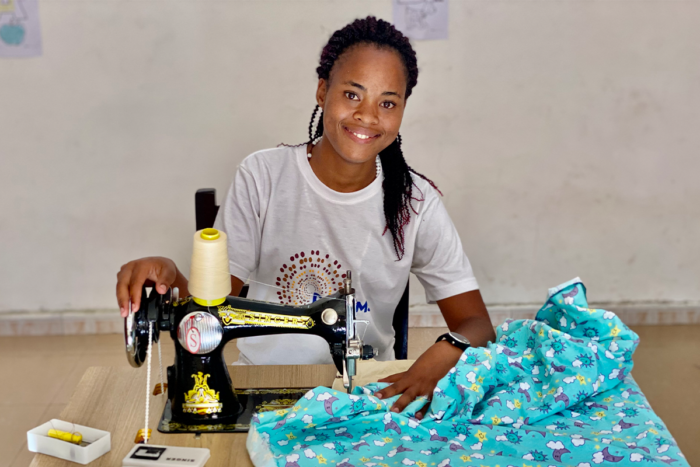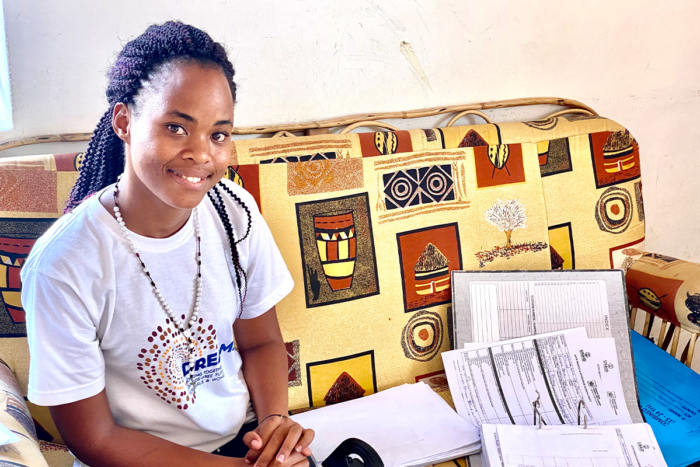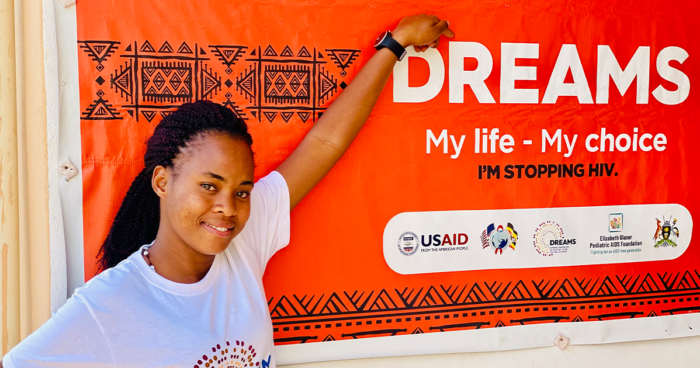
Ainembabazi Annitah, 21, sits at a desk in Mbarara, Uganda, with a sewing machine and large swaths of fabric.
She’s always wanted to be a fashion designer, and now she finally has the personal resources to pursue her dream. Just a few years ago, however, Annitah was struggling financially and at increased risk for acquiring HIV. Annitah explains that she transformed her life through the DREAMS program. She is now full of life, and as a DREAMS ambassador, she aspires to transform other girls’ lives in her community in southwest Uganda.
Before DREAMS
“As a child, I was raised by a single mother. When my mother disclosed her HIV-positive status she was sent away by my father’s relatives from our village home in the Mitooma district. Eventually my grandmother fostered my two siblings and me. I was able to attend school, but my highest level of education attained was Senior Four [10th Grade in the United States]. I could not continue because of resource constraints.
“As fate would have it, I got pregnant and, therefore, was perceived as a disgrace to my community. It was a painful nine months carrying the pregnancy—and worse still, without the support of the father of my child. I was insulted and treated as an outcast by close relatives and even discriminated against by a few health care providers at the local health facility where I regularly attended antenatal care.
“I decided to leave home and start a new life in Mbarara, two weeks after delivering my baby, with hope of finding work as a casual laborer in order to earn some money and take care of my son as well as meet my basic needs. Unfortunately, life was not as rosy as I hoped it would, being homeless with no money.
“I was approached by a stranger who gave me a ray of hope and took me into her home while I looked for a job. However, this relief was short lived, and a month later, my host threw me out of her home because her meager resources could not support a nursing mother and her baby.

“For two weeks, I combed the streets of Mbarara looking for shelter and food. I got to a point of wanting to end my life,” says Annitah, breaking into tears. However, not all hope was lost. A good Samaritan found her on the street and fostered her.
“In February 2021, the lady who had taken me in informed me about a program in the community that was enrolling girls, with the intention of helping them get empowered to better themselves. I was screened and enrolled into the DREAMS program, marking the start of my DREAMS journey.”
About the DREAMS project
The DREAMS project was developed through the U.S. President’s Emergency Plan for AIDS Relief (PEPFAR). It acts on social determinants of health related to higher risk of HIV infection—such as poverty, barriers to sexual and reproductive healthcare, and gender-based violence. DREAMS improves the quality of life for adolescent girls and young women by cultivating livelihood options outside of sex work and by improving access to family planning and testing for and prevention of sexually transmitted diseases.
Globally, 18.8 million adolescent girls and young women are living with HIV.1 Around 6,000 young women become infected with HIV each week, and in Sub-Saharan Africa, four out of five new HIV infections among youth aged 15-19 years are among young women and girls.2 Because of this disparity, UNAIDS data shows adolescent girls and young women as a priority population in reducing new HIV infections and achieving epidemic control.3
DREAMS helps avert HIV infection for young women like Anitah, while substantially improving their overall outcome in life. Anitah engages with a group of 18 other girls and young women at community safe spaces, aided by community facilitators.
“The DREAMS program has changed my life and will change the lives of many girls like me. DREAMS gave me hope to live to see another day.”
DREAMS for the future
“I received teachings on Stepping Stones, a curriculum which empowers us to make the right choices, such as staying HIV-negative, reporting cases of gender violence, making healthy relationships, and planning a family,” says Annitah.
“It has also helped me recognize that our sexual lives are embedded in a broader context of our relationships with our partners, families, and the community in which we live. How I wish I had known this information before. Perhaps I would have made different choices,” Annitah says through tears.

“My life has turned for the better. DREAMS has empowered me. I was skilled in baking and trained on saving and currently learning tailoring. In my group, we bake and sell our products. Some of the profit is shared while the rest is re-invested into the business. I am now able to rent a house for myself and my son.
“I want to change other girls’ life stories into success stories like mine. As a DREAMS Ambassador, I have used my position to advocate for better opportunities like what DREAMS offers, better health services and family planning for adolescent girls. I advocate for positive behavior change among my fellow peers. I also teach the Stepping Stones curriculum to my peers in the community.
“I am proud to be associated with the DREAMS Program. I am a DREAMS girl,” says Annitah.
“I have big dreams of becoming a fashion designer. I won’t give up until I achieve my dreams. I will work hard to make enough money and take care of my son, mother, and two sisters.
“The DREAMS program has changed my life and will change the lives of many girls like me. DREAMS gave me hope to live to see another day.”
“I am proud to be associated with the DREAMS Program.
I am a DREAMS girl.”
DREAMS—Determined, Resilient, Empowered, AIDS-free, Mentored, and Safe—is administered through USAID and the Elizabeth Glaser Pediatric AIDS Foundation (EGPAF) in southwest Uganda.
1. HIV Incidence Rates in Adolescent Girls and Young Women in Sub Saharan Africa. UNAIDS. 2018, New England Journal of Medicine, pp. 493-505.
2. Global HIV Statistics. UNAIDS. 5, 2016, Health Psychol, Vol. 18.
3. PEPFAR DREAMS Partnership. PEPFAR. 2020, Journal of Adolescent Health, pp. 106-121.




